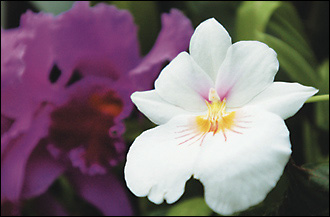Garden Classes Grow
Botanic Garden, Corcoran Team Up For New Program

Neena Birch, a mixed-medium artist, feels her profession does not always receive adequate respect.
But this spring, a partnership with the U.S. Botanic Garden that will enable the Corcoran College of Art and Design to begin allowing students to apply credits from certain courses toward a new certificate may help.
Courses in botanical painting in watercolor, botanical art in clay, painting orchids in watercolor, botanical field studies, basic botany and eight other areas will count toward a 15-credit certificate in botanical art and illustration, said Christina DePaul, dean of the college.
“Unfortunately, artists don’t get enough legitimacy,” she said. “It may help in the public eye that you have this certificate.”
Birch is interested in the opportunities that the Corcoran College of Art and Design offers but is not sure if she is ready to commit to the certificate.
“After 9/11 [botanical art] is an extremely calming focus,” said the artist, who has a master’s in drawing and painting. “You don’t have to fight with your subject and your model always shows up. It’s very rewarding.”
Botanical drawing courses began at the college in 1997 when Leslie Exton, an associate professor at the college and program head of the Department of Drawing and Painting for continuing education, taught her first botanical drawing course to seven students, Exton said. Until this spring, she had been the only professor at the college teaching such courses.
“Frankly, I wanted to teach what I like painting,” Exton, a botanical artist, said of the first course that she taught.
Exton emphasized that these are not “flower painting courses” but offer an artist the opportunity to create “precise, botanically accurate drawings.”
According to Exton, some schools offer similar programs, but the Corcoran’s will be the only college-level program that bears credit in the United States.
Exton has seen the number of courses that she is teaching increase from one to four and has published a book of her students’ work.
“It has just taken off like crazy,” Exton said. “What we needed was to be associated with a botanical garden where we would have plants and botany courses.”
Along with Clarissa Bonde, a student at the college, an artist and a member of the Board of the American Society of Botanical Artists and the College Board of the Corcoran, Exton began organizing the possibility of such a program last spring.
“The idea of the U.S. [Botanic] Garden and the Corcoran cooperating on the first college credited Botanical Certificate in this country seemed irresistible,” Bonde wrote in an e-mail. “The U.S. [Botanic] Garden could provide the scientific needs of the botanical artist and the Corcoran [could] expand the artistic expression within the limits of the requirements of a botanical artist and the artistic skills to experiment.”
Katie Palm, an education program specialist with the Botanic Garden, said the garden has partnerships with organizations such as the Denver Botanical Gardens, but it has never partnered with another organization to create a certificate program.
Although the garden offers classes such as silk painting, photography and a colored pencil class, this is the first time it has offered classes in which a person can obtain college credit.
Palm is excited about “the thought that it would be nice to take our collections and combine them to offer a top-notch certification program.”
Exton said she has inquiries from 10 people who are interested in the certificate program. Students who in the past audited courses that are now offered for certificate credit will have the opportunity to apply for the program and possibly receive credit for those courses.
“They can present a portfolio for review and can get credit for that work toward the certificate,” Exton said.
Exton said one of the benefits of the new program is that students will have the opportunity to learn from other professors. She added that one of the aims of the program is to “train illustrators who can accompany botanists to regions with endangered plants.”
Students will have the opportunity to learn from Robert Devers, a ceramicist who will teach the botanical art in clay course.
Denise Mullen, vice dean of the college, offered some insight into Devers’ work.
“[He] does large wall installation pieces out of clay,” Mullen said. “He has done a series based on elephant ears that he grows in his own gardens.”
Mullen said Devers is going to teach students to create molds directly from plants.
John Anderton, a freelance ornithologist and illustrator, will be teaching courses in the pen and ink techniques and painting birds and insects. Anderton, who does his freelance work from his home, sees teaching as an opportunity to get outside.
“We’re really keen on bringing people in from a number of different fields to make it a multifaceted program, not just fine arts,” Anderton said.
Anderton will focus on teaching his students to create a sufficient level of “technical detail” as well as producing work that is clear and would reproduce well.
Janet Torno, director of continuing education, said most of the courses began Jan. 21 and will last 14 or 15 sessions with meeting lengths that vary depending on the number of credits being awarded for the course.
The college will offer courses at the downtown campus located at the Corcoran gallery, at the Georgetown campus and at the Botanic Garden. Tuition is $825 for a 1.5-credit course and $1,650 for a three-credit course. Anyone with a high school diploma can register for the program at www.corcoran.edu/ ce/index.htm.





